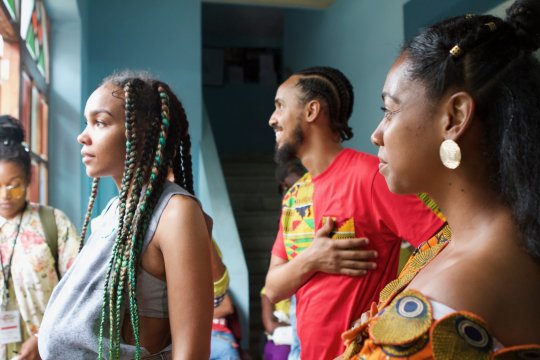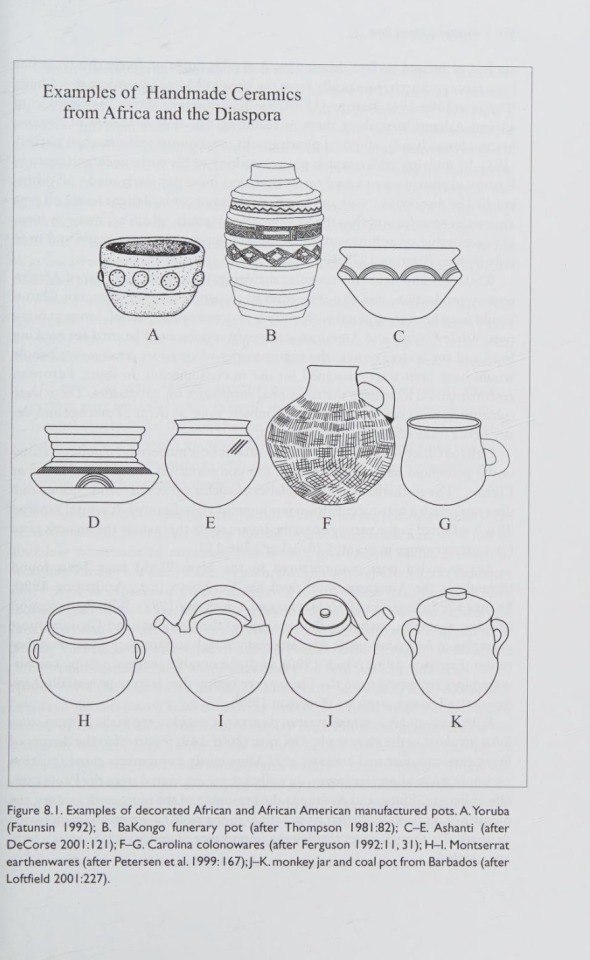#Bakongo
Text
Once you call yourself a Negro, the scientifically written you out of existence. There is no land called Negro, no language or culture- Malcolm X

Right now, in this country, if you and I, 22 million African-Americans -- that's what we are -- Africans who are in America. You're nothing but Africans. Nothing but Africans. In fact, you'd get farther calling yourself African instead of Negro.

Black names don't exist, black land does not exist, black language does not exist. Human skin comes from the darkest brown to the lightest hues. We are Africans. African populations have the highest levels of genetic variation among all humans.- Khepri Neteru

By the early 1900s, nigger had become a pejorative word in the United States. In its stead, the term colored became the mainstream alternative to negro and its derived terms. After the American Civil Rights Movement, the terms colored and negrogave way to "black". Negro had superseded colored as the most polite word for African Americans at a time when black was considered more offensive.[126][failed verification] This term was accepted as normal, including by people classified as Negroes, until the later Civil Rights movement in the late 1960s. One well-known example is the use by Dr. Rev. Martin Luther King Jr. of "Negro" in his famous speech of 1963, I Have a Dream. During the American civil rights movement of the 1950s and 1960s, some African-American leaders in the United States, notably Malcolm X, objected to the word Negrobecause they associated it with the long history of slavery, segregation, and discrimination that treated African Americans as second-class citizens, or worse.[127] Malcolm X preferred Black to Negro, but later gradually abandoned that as well for Afro-American after leaving the Nation of Islam.[128]
Since the late 1960s, various other terms for African Americans have been more widespread in popular usage. Aside from black American, these include Afro-American (in use from the late 1960s to 1990) and African American (used in the United States to refer to Black Americans, people often referred to in the past as American Negroes).[129]
In the first 200 years that black people were in the United States, they primarily identified themselves by their specific ethnic group (closely allied to language) and not by skin color. Individuals identified themselves, for example, as Ashanti, Igbo, Bakongo, or Wolof. However, when the first captives were brought to the Americas, they were often combined with other groups from West Africa, and individual ethnic affiliations were not generally acknowledged by English colonists. In areas of the Upper South, different ethnic groups were brought together. This is significant as the captives came from a vast geographic region: the West African coastline stretching from Senegal to Angola and in some cases from the south-east coast such as Mozambique. A new African-American identity and culture was born that incorporated elements of the various ethnic groups and of European cultural heritage, resulting in fusions such as the Black church and African-American English. This new identity was based on provenance and slave status rather than membership in any one ethnic group.
By contrast, slave records from Louisiana show that the French and Spanish colonists recorded more complete identities of the West Africans, including ethnicities and given tribal names.
The U.S. racial or ethnic classification "black" refers to people with all possible kinds of skin pigmentation, from the darkest through to the very lightest skin colors, including albinos, if they are believed by others to have African ancestry (in any discernible percentage). There are also certain cultural traits associated with being "African American", a term used effectively as a synonym for "black person" within the United States

#african#afrakan#kemetic dreams#africans#brownskin#brown skin#afrakans#african culture#Malcolm x#african ancestry#igbo#ashanti#bakongo#americas#epic video#middle class negro documentary
208 notes
·
View notes
Text

Bakongo (also known as Mkongo or Mukongo). In one of the Bantu languages, Kongo, the word “Ba” means “People” while “Kongo” according to an adventure means “Hunter” while according to others it means “Gathering” or “Mountains”. There is yet to a decisive context for it. Even the term “Congo” was a term used to refer to black people who spoke “Kikongo” in Cuba, America. The Bakongo people speak Kinkongo language which also compromises of 9 other language variations for different sub-branches of the Bantu tree; for example the Kivil dialect by the north coast, the Kisansolo in the central dialect, amongst others.
The 13th – 14th century saw the creation, transition, and building of the great Kingdom of Kongo. The kingdom succession was based on voting by the noble of the land which kept the king’s lineage among royalty. In the late 14th century, what was supposed to be a quick stop for the portugese

Allegedly, the Portuguese were in search of a route to India for opportunities when one Diego Cao found the river Congo. Moving south he and his companions found the people of Kongo in an organized system; valuable currency, trading relations, transport infrastructure, port settlements, and open-minded people.
The people of Kongo accepted them and even the king willingly accepted Christianity in a show of solidarity with these new people. Once a man, Chief Muanda, warned the people of the coming doom of slavery of the Bakugo clan which will destroy the kingdom, he said it will begin with the visitation of foreigners but people choose what they want to see even though he was later right. By the 19th century; the Kingdom of Kongo had completely fallen, the Bakongo people had fully divided and spread across different parts of the continent.
The Bankongo people are the third-largest group in Angola but in the 17th century, they lost a war to Portuguese during the repression. They moved throughout the continent occupying the northern regions of places like Cabinda, Congo, Angola and Zaire. In the 20th century, the Bakongo created a political party called the Union of Angolan Peoples (UPA) in an attempt to bring back all the Bakongo people, eventually, they decided an independent country filled with different tribes was much better for their society. Soon after that decision, they fought along the Ovimbundu and the Mbundu people for a better Angola.
In 1975, Angola gained its independence with a lot of Bakongo people being the faces for the win but as soon as the Mbundu people took over the ruling power there was discrimination among all three tribes. In the present time, their largest numbers are in Congo and though they’ve been through a lot, they have kept some of their cultural practices.
10 notes
·
View notes
Text
African Cosmology of the Bantu-Kongo (Bunseki Fu-Kiau) Chapter 4 #WeAreR...
Last in the series on this fascinating African philosophy book. I definitely want to read more of Bunseki Fu-Kiau's work.
2 notes
·
View notes
Video
youtube
Yannick Afroman - Bakongo ft. Sam Mangwana, Socorro, Kyaku Kyadaff, Gilmário Vemba
#youtube#Yannick Afroman - Bakongo ft. Sam Mangwana Socorro Kyaku Kyadaff Gilmário Vemba#Yannick Afroman#Yannick Afroman - Bakongo#Bakongo#Angola#Cabinda#DRC#CONGO#KONGO#Music
0 notes
Text
The Yaiwabian Spiritual Significance of Reptile and Amphibian Energies
In the rich tapestry of Yaiwabian spirituality, the animal kingdom holds profound symbolic significance, with each creature embodying unique energetic imprints that reflect the divine. Among these, reptiles and amphibians are particularly revered for their distinct spiritual attributes that mirror the cosmic duality and balance.
Reptile Energy: The Essence of Nzambi a Mpungu

Reptiles, with their ancient lineage and cold-blooded nature, are seen as carriers of the primordial life force. In Yaiwabian belief, the reptilian energy signature is a direct reflection of Nzambi a Mpungu, the Supreme God and Father of Creation. Nzambi a Mpungu is the essence of Spirit and Sun, representing the Sun’s fiery power, the spark of creation, and the transformative force of change.
This divine connection is mirrored in the reptile’s ability to shed its skin, symbolizing rebirth and renewal. The reptilian essence is thus associated with the themes of immortality, resilience, and the unyielding will to evolve and ascend.
Amphibian Energy: The Essence of Nzambici

Amphibians, creatures of both land and water, embody the fluidity of existence and the nurturing essence of life. The amphibian energy signature reflects Nzambici, the Supreme Goddess and Mother of Creation. Nzambici is the divine feminine & essence of the Soul and Moon, the nurturing force that gives birth to all forms and sustains them with her boundless love and wisdom.
The amphibian’s life cycle, from water-dwelling tadpole to land-roaming adult, symbolizes the journey of the soul through various states of being, embracing change while maintaining a connection to the source.
Integrating Reptile and Amphibian Energies

In Yaiwabian practice, integrating the energies of reptiles and amphibians into one’s spiritual life can lead to a deeper understanding of the universe’s dual nature. By embracing the fiery, transformative energy of the reptile and the gentle, life-giving energy of the amphibian, one can achieve a harmonious balance between action and receptivity, strength and compassion, light and shadow.
Through meditation, ritual, and reflection, adherents can tap into these potent energies, allowing for personal growth and a greater connection to the divine forces represented by Nzambi a Mpungu and Nzambici.
This exploration of reptile and amphibian energies within the Yaiwabian spiritual framework offers a glimpse into the profound wisdom and interconnectedness of all life. By recognizing the divine essence in these creatures, we can learn to appreciate the myriad ways the sacred manifests in our world.
-Lord Yaiwa, The Voodoo Prince
#lord yaiwa#The Voodoo Prince#Divine Masculine#Divine Feminine#Yaiwabian#Black Magick#White Magick#Starseed#Starseeds#Spirituality#Soulfuality#Voodoo#Bakongo
1 note
·
View note
Text

Dois mundos.
Nankin, acrílica e guache sobre tela.
15cm x 20cm.
#bakongo#bantu-kongo#bakongo cosmology#dikenga dya kongo#cosmograma bakongo#cultura negra#painting#nankin#fu-kiau
1 note
·
View note
Text
ki-ndoki
“A escola iniciática de conscientização oferece a seus membros a sagrada ciência multidimensional, a KI-ndoki, da tradição da escola do Kongo. Esta ciência sagrada é a de uma linguagem multidimensional de luz, eles são, de símbolos de código e para energia. É a base de todas as formas de aprendizagem, tanto como arte criativa quanto como ciência altamente técnica.
Ao contrário do que foi…
View On WordPress
0 notes
Video
youtube
Hiking BORNEO!! 🇲🇾 Bako National Park Cliff JUNGLE (MALAYSIA)
#bakongo#bakonationalpark#hiking#hikingborneo#hikingmalaysia#junglehike#sarawak#kuching#travelvlog#borneo#borneotravel
1 note
·
View note
Text
I know the Catholics be having a field day with Blasphemous but as someone who is apart of an ATR who’s practice does incorporate Catholic/Christian imagery and stories this game HITS
#I wonder if any Paleros/Paleras have played and noticed Zarabanda being mentioned#I think that on the surface everyone thinks this is just a dark Catholic metroidvania#but I see someone is deep in the occult and found an outlet to express that#the concepts of how the miracle work even tie into how spirits transition in the bakongo cosmology#ugh I just love blasphemous#blasphemous#game kitchen
5 notes
·
View notes
Text
Exploring the Rich Linguistic Heritage of Kikongo and Kituba Languages in the Kongo Kingdom
Uncovering the Secrets of the Kikongo Language and People
Located in the heart of Central Africa, the Kikongo language has a rich cultural heritage that has been passed down through the centuries. This ancient language spoken by the Bakongo people provides fascinating insight into the region’s history, traditions and way of life. In this article, we delve into the fascinating world of the…

View On WordPress
#African Languages#Bakongo people#Bantu languages#Cultural Heritage#inclusivity#Interpretation Services#Kikongo language#Kongo Kingdom#Language Preservation#LanguageXS
1 note
·
View note
Text
CE JOUR-LÀ ... 4 janvier 1959, émeutes à Léopoldville dont les morts seront considérés comme «martyrs de l'indépendance»
L’annulation ce jour-là par l’autorité coloniale d’un meeting de l’ABAKO (Alliance des Bakongo, parti de Kasa-Vubu) provoque la colère et la frustration.
Les partisans de l’ABAKO sont vite rejoints par une foule nombreuse des supporters furieux de l’équipe de football Vita Club, sortant du grand stade Roi Baudouin proche, où leur équipe venait de perdre son match contre l’équipe Mikado.
A partir…

View On WordPress
#4 janvier 1959#émeutes à Léopoldville dont les morts seront considérés comme «martyrs de l&039;indépendance»#l’autorité coloniale d’un meeting de l’ABAKO (Alliance des Bakongo#parti de Kasa-Vubu)
0 notes
Text

According to Dr. Yvonne Chireau, "Hoodoo is an African American-based tradition that makes use of natural and supernatural elements in order to create and effect change in the human experience."

Hoodoo was created by African Americans, who were among over 12 million enslaved Africans from various Central and West African ethnic groups being transported to the Americas from the 16th to 19th centuries (1514 to 1867) as part of the transatlantic slave trade. The transatlantic slave trade to the United States occurred between 1619 and 1808, and the illegal slave trade in the United States occurred between 1808 and 1860. Between 1619 and 1860 approximately 500,000 enslaved Africans were transported to the United States.

From Central Africa, Hoodoo has Bakongo magical influence from the Bakongo religion incorporating the Kongo cosmogram, Simbi water spirits, and Nkisi and Minkisi practices. The West African influence is Vodun from the Fon and Ewe people in Benin and Togo following some elements from the Yoruba religion. After their contact with European slave traders and missionaries, some Africans converted to Christianity willingly, while other enslaved Africans were forced to become Christian which resulted in a syncretization of African spiritual practices and beliefs with the Christian faith.

Enslaved and free Africans learned regional indigenous botanical knowledge after they arrived to the United States. The extent to which Hoodoo could be practiced varied by region and the temperament of the slaveholders. For example, the Gullah people of the coastal Southeast experienced an isolation and relative freedom that allowed retention of various traditional West African cultural practices. Gullah people and enslaved African-Americans in the Mississippi Delta, where the concentration of slaves was dense, Hoodoo was practiced under a large cover of secrecy. The reason for secrecy among enslaved and free African Americans was that slave codes prohibited large gatherings of enslaved and free African people. Slaveholders experienced how slave religion ignited slave revolts among enslaved and free African people, and some leaders of slave insurrections were African ministers or conjure doctors

#african#afrakan#kemetic dreams#africans#brownskin#afrakans#brown skin#african culture#afrakan spirituality#bakongo#congo#conjure#ancestor veneration#rootwork#hoodoo#nkisi#simbi#botanical#botanic garden#gullah#gullah geechee#gullah gullah island#mississippi#mississippi delta#slave codes#vodun#cosmogram#yoruba#america#african american
185 notes
·
View notes
Video
youtube
Why Kongo Spirituality Is Not As Popular in the American Diaspora
ONE REASON WHY TRADITIONAL KONGO SPIRITUALITY MAY NOT BE AS POPULAR IN THE AFRICAN AMERICAN DIASPORA ~ Iya J. Oftentimes, when many people think of Kongo spirituality, they think of branches such as Palo Mayombe.
However, there is a traditional aspect of Kongo spirituality still practiced in Africa. Here are some tips on how to bridge the gap and begin to understand Kongo Spirituality from a perspective of its origins.
#youtube#Why Kongo Spirituality Is Not As Popular in the American Diaspora#BaKongo#congo#Kongo#BaKongo spirituality#ATR#african traditional religions
3 notes
·
View notes
Text
100 days of mental healthcare: day 72/100




You know those days when everything goes wrong? My day started like this. I lost track of time and had a terrible and disorganized morning. My ADHD got in the way and I was only able to sit down to plan my day around 10:30 am. In the end, the afternoon didn't go as planned either, but I managed to focus on work and studying for a few hours — at least until I was interrupted by my cat, who apparently thinks that studying Korean double consonants is useless, since she stopped in front of the screen.
Answering 4/30 self-knowledge questions about myself: What motivates me to wake up every day?
This is complicated. I have suffered from years and years of severe depression, in which there were few reasons to get out of bed. Today I still feel a little bit like this. Waking up every day is scary: what if I have a panic attack? what if I come across a trigger? I live in fear. But I chose to keep going because I really have some strong reasons to live: my husband, my cats, my desire to be a mother, my community, my ancestors… As an Umbandista, I believe that my ancestors live through me, so I do my best to connect with them and live with them. There are still bad days, but another reason that makes me wake up every day is the hope for good days.
🥀: day 19/28
💧: 1,5 L
🏃🏻♀️: 1306 steps
🏋🏻♀️: 🚫
📝: journaling (1h)
📖: studied the basics of the bakongo cosmogram (1h)
🇰🇷: studied double consonants and learned new words with them, such as 짜장면 (jjajangmyeon) and 아빠 (dad)
🎧: louvação a oxum - Maria Bethânia
🎮: 🚫
📺: one piece ep. 431-434
📚: 🚫
🛑: 2 days pick-free
💊: all vitamins were taken
#my thoughts#journaling#mental health#getting better#100 days#100 days challenge#100 days of mental healthcare#mental healthcare#mental health support#chu diaries#korean langblr#lang blog#korean language#language learning#langblr#booklr#study inspo#study hard#study space#study#study blog#studyspo#study motivation#study inspiration#studying#studyblr#study aesthetic#studyblr community#african studies#daily life
49 notes
·
View notes
Video
youtube
Yannick Afroman - Bakongo ft. Sam Mangwana, Socorro, Kyaku Kyadaff, Gilmário Vemba
Yannick Afroman - Bakongo ft. Sam Mangwana, Socorro, Kyaku Kyadaff, Gilmário Vemba
#youtube#Yannick Afroman#Bakongo#Sam Mangwana#socorro#Kyaku Kyadaff#Gilmário Vemba#Kongo Dia Ntotila#Bantu#Kikongo#Mukongo#People#DRC Congo#Cabinda#Angola#Languages#português#culture#food#countries#tribe#music
0 notes
Text

“Figure 8.1. Examples of decorated African and African American manufactured pots. A. Yoruba (Fatunsin 1992); B. BaKongo funerary pot (after Thompson 1981:82); C-E. Ashanti (after DeCorse 2001:121); F-G. Carolina colonowares (after Ferguson 1992:11,31); H-I. Montserrat earthenwares (after Petersen et al. 1999: 167):J-K. monkey jar and coal pot from Barbados (after Loftfield 2001:227).”
From: “Sampling many pots: An archaeology of memory and tradition at a Bahamian plantation” by Wilkie, Laurie A.; 2005.
36 notes
·
View notes